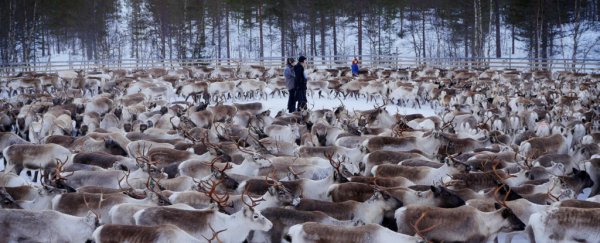The holiday spirit might not totally explain what makes Rudolph's nose glow so bright.
Thirty years after a nuclear power plant exploded at Chernobyl, the reindeer that walk the picturesque, snow-capped mountains of Scandinavia are still radioactive.
They weren't the only ones affected. For generations, the Sami people, native to the Arctic North, lived in harmony with nature.
Many worked as boazovázzi, or 'reindeer walkers', herding the animals over hundreds of miles of terrain and selling their meat come slaughter season. The reindeer were a cultural and economic centrepiece for the Sami people.
But the explosion - considered the worst civilian nuclear disaster in history - coated the earth with toxic material, turned the reindeer radioactive, and poisoned the Sami people's way of life.
Photographer Amos Chapple with Radio Free Europe traveled to the Norwegian village of Snasa, where he met with herders fighting to preserve their traditions.
Chapple shared a few photos with us below, and you can read the whole story here.
In the fallout of Chernobyl, streams of radioactive material spewed into the atmosphere above the Soviet Union and across Europe. Among the most dangerous fission products was cesium-137.
 Volodymyr Repik/AP
Volodymyr Repik/AP
Wind and rain carried contaminants to the ground. In Norway, a relentless downpour allowed 700 grams of radioactive cesium-137 to settle on the ground there.
 Frank Rumpenhorst/AO
Frank Rumpenhorst/AO
Source: Radio Free Europe
The radioactive materials poured into the lakes and forests, contaminating wildlife, berries, and plants. It also got to a spindly green fungus called lichen, a reindeer's favourite snack.
Lichen has no roots system and absorbs nutrients from the air, making it well suited to sponge up all that cesium-137. The reindeer gorged themselves and became radioactive.
 Amos Chapple
Amos Chapple
Source: University of Texas
For 9,000 years, the Sami people tied their cultural identity to the reindeer. The animal provided food, income, and traditions they passed on. Chernobyl brought an abrupt end.
 Amos Chapple
Amos Chapple
Source: Associated Press
In 1986, scientists detected levels of radiation in the reindeer unfit for human consumption. European governments passed strict regulations, and the Sami people released their herds back to the wild.
 Amos Chapple
Amos Chapple
Source: University of Texas
"The aftermath of Chernobyl was devastating," Chapple tells Business Insider.
"[The herders] went from living this timeless lifestyle, completely at one with nature, to suddenly working in one of the most contaminated places on earth."
 Amos Chapple
Amos Chapple
Thirty years later, conditions have improved. The radioactivity of the cesium-137 released has decayed by half, but much of the slow-growing lichen remains unsafe. In 2014, hundreds of reindeer failed inspection due to strong fungus growth.
 Amos Chapple
Amos Chapple
Source: Cultural Survival and Radio Free Europe
Sami herders in Snasa, who eat reindeer, get tested annually for radiation. They tell Chapple they will always live in the shadow of Chernobyl.
 Bjorn-Owe Holmberg/AP
Bjorn-Owe Holmberg/AP
This article was originally published by Business Insider.
More from Business Insider:

